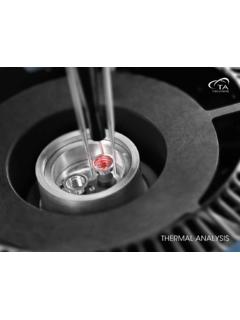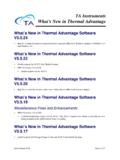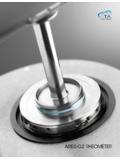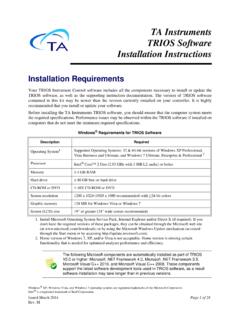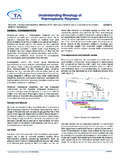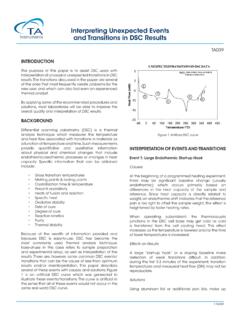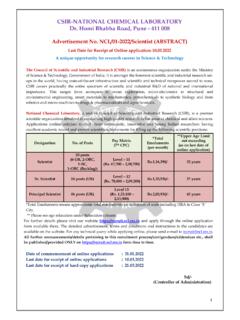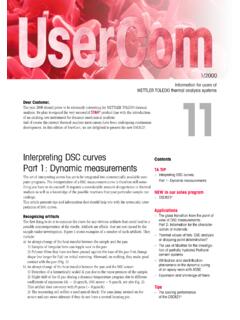Transcription of Materials Characterization by Thermal Analysis (DSC & …
1 Materials Characterization by Thermal Analysis (DSC & TGA), Rheology, and Dynamic Mechanical AnalysisCharles Potter Thermal Application ScientistSarah Cotts Rheology Application ScientistFred Wiebke Territory Manager TA InstrumentsFacts about TA Instruments Global market leader in Thermal Analysis , thermophysical properties, microcalorimetry and rheology. Headquartered in New Castle, DE along with 200,000 sq. ft. of manufacturing and support Additional manufacturing in Utah and Germany Direct Sales Offices in 28 countriesWhat Does TA Instruments Measure? Thermal Analysis & RheologyDSC, DTCTGADMA RheometerTMADILT hermal Analysis , Rheology,Thermophysical Properties Techniques Differential Scanning Calorimetry (DSC) Modulated DSC Thermogravimetric Analysis (TGA) Vapor Sorption Analysis (SA) Dynamic Mechanical Analysis (DMA) Rheometer Isothermal Calorimetry (TAM) Thermomechanical Analysis (TMA) Flash Diffusivity Thermal Conductivity Dilatometry (DIL)Agenda Morning: Techniques and Applications Case Study Automotive Industry Differential Scanning Calorimetry Thermogravimetric Analysis Simultaneous Differential Thermal Analysis Complimentary Thermal Analysis Techniques Afternoon: Techniques and Applications.
2 Dynamic Mechanical Analysis (Q800 and RSA) Rheology (DHR and ARES) Techniques and Applications Case Studies Rheology/DSC/TGA/SDT Rubber Rheology Case Studies Rubber Rheology and DSC Load Frame High Force, Fatigue TestingWrap up about 4:00 pm- Case Study - Thermal Analysis in the Automotive IndustryComposition of an AutomobileBuilding a Lighter Automobile30% weight reduction50% weight reductionAluminum Tailor Welded Blanks40% weight reduction / 50% reduction in part countSuperplastic Forming35% weight reduction / reduction in part count40% weight reduction / 10 X reduction in part countHydroformingMetal Matrix CompositesPowertrain components - 40% weight reduction Reduces mass by 60%Magnesium AlloyLightweight GlazingThermoplastic CompositesPhoto: Courtesy of GKN AerospaceWhat is Thermal Analysis ? Thermal Analysis is a series of techniques that provide physical property measurement as a function of temperature, time, and other Techniques Differential Scanning Calorimetry (DSC) - heat Modulated DSC (MDSC ) Thermogravimetric Analysis (TGA) weight Simultaneous DSC/TGA (SDT) Vapor sorption Analysis Thermomechanical Analysis (TMA) - dimension Dynamic Mechanical Analysis (DMA) - modulus Can also be considered a solids rheometer Analysis of Automotive Materials What is it?
3 Thermoplastics Thermosets Amorphous material Rubber and Elastomers What is it? What is it? or What is it not? DSC and TGA, along with infrared spectroscopy, are an excellent starting point for Characterization of new or unknown Canada You will need a bunch of this to buy anything .. including a CAR-2-10123 Heat Flow T4P (W/g)-50050100150200250 Temperature ( C) Exo UpUniversal TA InstrumentsThermoplastic Polymers Agenda Thermoplastics What are thermoplastics? Melting Crystallization Crystalline Content Thermal Stability Oxidative StabilityThermoplasticsSemi-Crystalline (or Amorphous)Crystalline Phasemelting temperature Tm(endothermic peak)Amorphous Phaseglass transition temperature (Tg)(causing Cp)Tg < TmCrystallizable polymer can crystallize on cooling from the melt at Tc(Tg < Tc < Tm)DSC Melting of Polyethylene vs Indium100110120130140150160170-20-15-10- 505 Temperature ( C)Heat Flow (mW) CDifferent Types of PolyethylenePeak shape depends on.
4 Molecular weight distribution and branching Crystallinity Crystallite morphology as determined by Thermal history Differences affect end-use performance-20-15-10-50 Heat Flow (W/g)406080100120140160 Temperature ( C)Exo UpCrystallization Crystallization is an exothermic peak in a DSC scan Crystallization is molten amorphous material changing to crystalline material upon cooling Cold-Crystallization is solid amorphous material changing to crystalline material upon heating Crystallization is a kinetic, two-step process Nucleation Crystal growthCrystallization Crystallization is a kinetic process which is typically studied either while cooling or isothermal, but can also be studied during heating (Cold-Crystallization) Differences in crystallization temperature or time (at a specific temperature) between samples can affect end-use properties as well as processing conditions Isothermal crystallization is the most sensitive way to id entify differences in crystallization rates Effect of Cooling RateCoolingRe-crystallization20 C/min10 C/min5 C/min02468 Heat Flow (W/g)-203080130180 Temperature ( C) Exo UpUniversal TA Instruments1151201251301350246 What is happening?
5 Gold CKK hermetic lidExo Flow (W/g)405060708090100110120130140150160 Temperature ( C)Exo UpPOLYPROPYLENEWITH NUCLEATING AGENTSPOLYPROPYLENEWITHOUT NUCLEATING Flow (W/g)6080100120140160180200 Temperature ( C)Exo UpCrystallizationmeltingEffect of Nucleating AgentsCoolingWhat is Isothermal Crystallization? A Time-To-Event ExperimentAnnealing TemperatureMelt TemperatureIsothermal Crystallization TemperatureTimeZero TimeIsothermal CrystallizationCrystallizationHeat capacity due to cooling-10123H e a t F lo w (m W )0246810121416 Time (min)TemperatureTemperature Time-to-Tmax characterizes differences A time-to-event Analysis Requires rapid cooling and equilibrationPolyethylene OxideDetermination of Crystallinity of a common Automotive Thermoplastic:PET/ABS Blend - Conventional ( C)50100150200250 Heat Flow (W/g)first heat on molded part(Curve shifted on Y axis to avoid overlap)second heat after 10 C/min C (H) mg sample, nitrogen purge 10 C/minute heating ratePET/ABS Blend - sample nitrogen purge 2 C/minute heating rate, 1 C amplitude, 60 second periodfirst heat on molded part PET TgABS Temperature ( C)4060100120140 Heat Flow (mW) ( ) Nonrev.
6 Heat Flow (W/g)( ) Rev. Heat Flow (W/g) C+ C (H) C (H)180200 Thermal and Oxidative Stability Thermal and Oxidative Stability Can be studied by multiple techniques Studied in inert or oxidizing atmospheres TGA Best starting point Weight loss or gain DSC Change in heat flow (typically exothermic) Can also see the effect in other techniqueslike DMA & TMAS tarting Point for material Characterization First Step Thermogravimetric Analysis Look for: Thermal and Oxidative Stability Volatiles Decomposition Temperature Weight Loss Profile Number of Steps Residue Char/Ash/Filler PresenceOxidative Stability - C020406080100120 Weight (%)02004006008001000 Temperature ( C) PP Resin Nitrogen PP Resin Air Universal TA InstrumentsPolyethylene Oxidation Onset C-20-1001020 Heat Flow (mW)50100150200250300 Temperature ( C)Oxidation Onset Temperature (OOT)OIT of LDPE of Cable Coatings200 200 200 200 CCCCT hermal Stability of PolymersM ethod Log: 1:Select gas: 1 - N 21: R am p C /m in to C2: Select gas: 2 - A ir3: R am p C /m in to CPVCPM M (%)502504506508501050 Temperature ( C)Block versus Random Copolymers0100200300400500050100 Temperature ( C)Weight (%)S - MSRANDOMS - MS BLOCKP - MSPS size:8 mgprog:6 C/minatm.
7 300 Pa vacuumThermosetsThermosetsThermosetting polymers react (cross-link) irreversibly. A+B will give out heat (exothermic) when they cross-link (cure). After cooling and reheating C will have only a glass + B CGLUET hermosetting Polymers Thermogravimetric Analysis Thermal and Oxidative Stability Composition and Filler Flame Retardants Differential Scanning Calorimetry Glass Transition Temperature Heat of Reaction Heat Capacity Extent of cure Other Techniques Viscosity Modulus Dimensional Change and CTE Thermal Conductivity Dielectric OthersCuring of a Thermosetting Min Epoxy Cured in DSC15 .15mg @ 10 C/min-6-4-202468 Heat Flow (mW)050100150200 Temperature ( C)Exo UpUniversal TA Instruments Interpretation of peak shape Heat flow displacement proportional to reaction rate, dx/dt Fraction of peak area is fraction reacted, x Kinetic equation:dx /dt = fn(x)*KeEa/RT Predict reaction ratesKinetically Controlled Percent (%)-4-202468 Heat Flow T4P (mW)-50050100150 Temperature ( C)Exo UpEpoxy cureEffect of Heating Flow T4 (W/g)100120140160180200220240T em perature ( C )1 C /m in2 C /m in5 C /m in10 C /m in20 C /m inAmorphous StructureCharacterization of Amorphous Structure Glass Transition (Tg) Due to amorphous (non-crystalline) structure Due to macro-molecular motion (translational); , the entire molecule is free to move relativeto adjacent molecules.
8 Extremely important transition because the significant change in molecular mobility at Tg causes significant changes in physical properties and reactivityChanges at the TgHeat FlowHeat CapacityTemperature Below Tg - lower Cp - lower Volume - lower CTE - higher stiffness - higher viscosity - more brittle - lower enthalpyGlass Transition is Detectable by DSCB ecause of a Step-Change in Heat [ ] Heat Flow (mW) Capacity (J/g/ C)7090110 Temperature ( C)Exo UpUniversal TA InstrumentsPolystyrene - Modes of Molecular Motion/MobilityVibrationRotationTranslat ionElastomer Tg by C(H)Elastomer - - 10 Flow (mW)-80-60-40-20020 Temperature ( C)Exo UpUniversal TA InstrumentsQuantification of Amorphous Structure% Amorphous = = 41%Change in Cp @ Tg is a measure of amorphous structurePartially Miscible Amorphous C (H ) / C (H ) / C (H ) / C (H ) / CP CA B S -P CA B Cp (J/g/ C)80100120140160 Temperature ( C) If not miscible then Tg s don t shift If completely miscible then a single Tg in the middleABS-PC Copolymer Alloy Glass Transition by TMA and DMAG lass Transition Temperature by TMASam ple: P M M AH eating R ate: 5 C /m inM acro expansion C-40-2002040 Dimension Change ( m)2575125 Temperature ( C)Tg is the Extrapolated Onset TemperatureGlass Transition Temperature by CP olycarbonate1H z, 15 m am plitude3 C /m Delta0.
9 111 01 0 01 0 001 0 00 0 Loss Modulus (MPa)0 .111 01 0 010 0 01 00 0 0 Storage Modulus (MPa)1 001 2 014 01 6018 0 Temperature ( C )Universal TA Instrum entsTg can be the Extrapolated Onset Temperature of Modulus ChangeTg can be the Peak of the Loss ModulusTg can be the Peak of the Tan DeltaOverview of DSC and TGA for Rubber and ElastomersThermogravimetric Analysis (TGA) TGA measures amount and rate of weight change vs. temperature or time in a controlled atmosphere Used to determine composition and Thermal stability up to 1000 C (55 1200 C (Discovery 5500) & 1500 C (650 SDT) Characterizes Materials that exhibit weight loss or gain due to decomposition, oxidation, or dehydrationStyrene-Butadiene Rubber Analysis02004006008001,0000255075100 Temperature ( C)Wt (%) Carbon Black5% Inert FillerSample weight: 30 mgProgram rate : 20 C/minAtmosphere : N , Air2 TGA of Tire Oil( ) Polymer( ) Carbon( ) ( )TGA mg of Tire Rubber Compound20 C/min to 600 C in N220 C/min to 1000 C in air024681012 Deriv.)
10 Weight (%/min)020406080100 Weight (%)02004006008001000 Temperature ( C)Universal TA InstrumentsTGA of Rubber in ( ) ( ) ( )-11 Deriv. Weight (%/ C)20406080100120 Weight (%)2004006008001000 Temperature ( C)Sample: Rubber 10C/min N2 - Green ColorantSize: mg TGA Rubber in ( ) ( ) ( )-20246 Deriv. Weight (%/ C)20406080100120 Weight (%)2004006008001000 Temperature ( C)Sample: Rubber 10C/min Air - Green ColorantSize: mg TGA Rubber in Air vs ( ) ( ) ( ) ( ) ( ) ( ) C-20246 Deriv. Weight (%/ C)20406080100120 Weight (%)2004006008001000 Temperature ( C) Rubber 10 Cmin Air - Green Rubber 10 Cmin N2 - Green Decomposition of Elastomers in NitrogenVolatilization of Plasticizers/OilsVacuum Can Improve SeparationAmbient PressureEPDM Rubber @ 10 C/min100 millitorr-20020406080100120 Weight (%)0100200300400500600 Temperature ( C)Universal TA InstrumentsTGA: Evolved Gas Analysis Discovery Mass Spectrometer (DMS) Benchtop, unit resolution quadrupole mass spec designed and optimized for evolved gas Analysis (EGA) Quadrupole detection system a closed ion source a quadrupole mass filter as sembly dual detector system (Faraday and Secondary Electron Multiplier).

